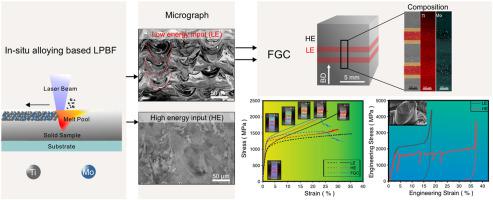Composites Part B: Engineering ( IF 13.1 ) Pub Date : 2021-06-07 , DOI: 10.1016/j.compositesb.2021.109059 Ranxi Duan , Sheng Li , Biao Cai , Zhi Tao , Weiwei Zhu , Fuzeng Ren , Moataz M. Attallah

|
β-titanium (Ti) alloys combined with high strength and good ductility have attracted extensive research interest for use in many advanced industrial applications. In this study, laser powder bed fusion (LPBF) parameters were firstly optimised to fabricate highly dense metastable β Ti–12wt% Mo alloy with largely homogeneous structure from low-cost elemental powders. When the laser area energy density (AED) increased to 4 J/mm2 using the simple scan mode, the refractory Mo powder melted and dissolved into the Ti matrix due to the increased melting pool temperature and increased cycles of remelting. However, when the same high AED was used in the chess scanning mode, keyhole-induced defects emerged along the island boundaries. The laser beam delay (LBD) and island spacing (IS) settings were then optimised to eliminate keyhole defects. Additionally, it is found that using low and high AED (e.g. 1.6 and 4 J/mm2 respectively), the builds show significantly different microstructure and mechanical properties. In view of this, a Ti–Mo functional gradient composite (FGC) was fabricated via alternating AEDs of 1.6 and 4 J/mm2 layer-wise. A gradient distribution of α” phase with varied size and quantities across the designed layer boundaries was produced. The Ti–Mo FGC possessed a high compressive yield strength of 1173 (±15) MPa and improved strain hardening capacity. The developed approach demonstrated the potential for the fabrication of FGCs using an in situ alloying based LPBF.
中文翻译:

基于原位合金化的β Ti-Mo合金激光粉末床熔融加工制备功能梯度复合材料
β-钛 (Ti) 合金与高强度和良好的延展性相结合,在许多先进的工业应用中引起了广泛的研究兴趣。在这项研究中,激光粉末床融合 (LPBF) 参数首先被优化,以从低成本的元素粉末制造高密度亚稳态 β Ti-12wt% Mo 合金,该合金具有基本均匀的结构。当激光面能量密度 (AED) 增加到 4 J/mm 2使用简单扫描模式,由于熔池温度升高和重熔周期增加,难熔钼粉熔化并溶解到钛基体中。然而,当在国际象棋扫描模式中使用相同的高 AED 时,沿岛边界会出现锁孔引起的缺陷。然后优化激光束延迟 (LBD) 和岛间距 (IS) 设置以消除小孔缺陷。此外,发现使用低和高 AED(例如分别为 1.6 和 4 J/mm 2),构建显示显着不同的微观结构和机械性能。鉴于此,通过 1.6 和 4 J/mm 2 的交替 AED 制造了 Ti-Mo 功能梯度复合材料 (FGC)逐层。在设计的层边界上产生了具有不同尺寸和数量的α”相的梯度分布。Ti-Mo FGC 具有 1173 (±15) MPa 的高压缩屈服强度和改进的应变硬化能力。所开发的方法证明了使用基于原位合金化的 LPBF 制造 FGC 的潜力。


























 京公网安备 11010802027423号
京公网安备 11010802027423号